Flex 自定义组件要重写的方法
- 格式:docx
- 大小:21.37 KB
- 文档页数:5
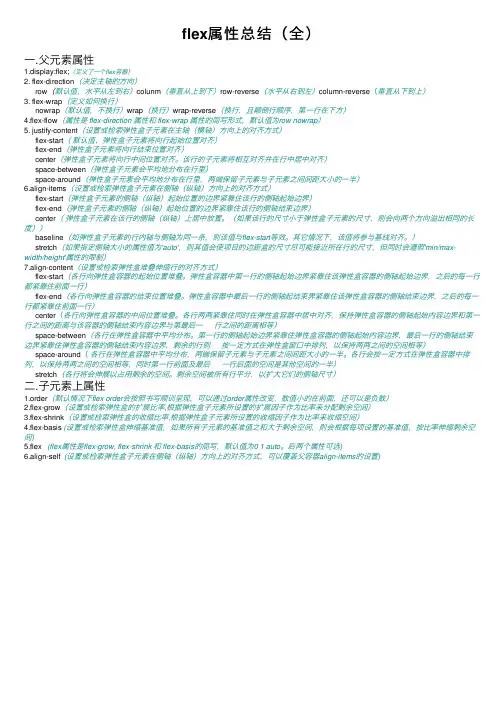
flex属性总结(全)⼀.⽗元素属性1.display:flex;(定义了⼀个flex容器)2. flex-direction(决定主轴的⽅向)row(默认值,⽔平从左到右)colunm(垂直从上到下)row-reverse(⽔平从右到左)column-reverse(垂直从下到上)3. flex-wrap(定义如何换⾏)nowrap(默认值,不换⾏)wrap(换⾏)wrap-reverse(换⾏,且颠倒⾏顺序,第⼀⾏在下⽅)4.flex-flow(属性是 flex-direction 属性和 flex-wrap 属性的简写形式,默认值为row nowrap)5. justify-content(设置或检索弹性盒⼦元素在主轴(横轴)⽅向上的对齐⽅式)flex-start(默认值、弹性盒⼦元素将向⾏起始位置对齐)flex-end(弹性盒⼦元素将向⾏结束位置对齐)center(弹性盒⼦元素将向⾏中间位置对齐。
该⾏的⼦元素将相互对齐并在⾏中居中对齐)space-between(弹性盒⼦元素会平均地分布在⾏⾥)space-around(弹性盒⼦元素会平均地分布在⾏⾥,两端保留⼦元素与⼦元素之间间距⼤⼩的⼀半)6.align-items(设置或检索弹性盒⼦元素在侧轴(纵轴)⽅向上的对齐⽅式)flex-start(弹性盒⼦元素的侧轴(纵轴)起始位置的边界紧靠住该⾏的侧轴起始边界)flex-end(弹性盒⼦元素的侧轴(纵轴)起始位置的边界紧靠住该⾏的侧轴结束边界)center(弹性盒⼦元素在该⾏的侧轴(纵轴)上居中放置。
(如果该⾏的尺⼨⼩于弹性盒⼦元素的尺⼨,则会向两个⽅向溢出相同的长度))baseline(如弹性盒⼦元素的⾏内轴与侧轴为同⼀条,则该值与flex-start等效。
其它情况下,该值将参与基线对齐。
)stretch(如果指定侧轴⼤⼩的属性值为'auto',则其值会使项⽬的边距盒的尺⼨尽可能接近所在⾏的尺⼨,但同时会遵照'min/max-width/height'属性的限制)7.align-content(设置或检索弹性盒堆叠伸缩⾏的对齐⽅式)flex-start(各⾏向弹性盒容器的起始位置堆叠。
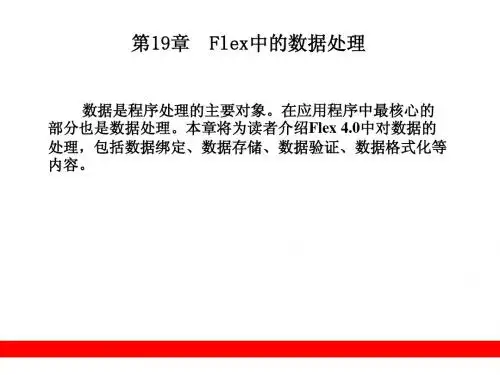
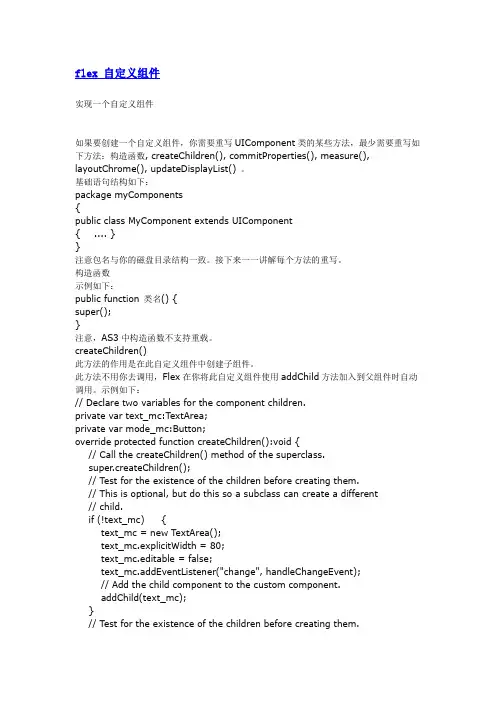
flex 自定义组件实现一个自定义组件如果要创建一个自定义组件,你需要重写UIComponent类的某些方法,最少需要重写如下方法:构造函数, createChildren(), commitProperties(), measure(), layoutChrome(), updateDisplayList() 。
基础语句结构如下:package myComponents{public class MyComponent extends UIComponent{ .... }}注意包名与你的磁盘目录结构一致。
接下来一一讲解每个方法的重写。
构造函数示例如下:public function 类名() {super();}注意,AS3中构造函数不支持重载。
createChildren()此方法的作用是在此自定义组件中创建子组件。
此方法不用你去调用,Flex在你将此自定义组件使用addChild方法加入到父组件时自动调用。
示例如下:// Declare two variables for the component children.private var text_mc:TextArea;private var mode_mc:Button;override protected function createChildren():void {// Call the createChildren() method of the superclass.super.createChildren();// Test for the existence of the children before creating them.// This is optional, but do this so a subclass can create a different// child.if (!text_mc) {text_mc = new TextArea();text_mc.explicitWidth = 80;text_mc.editable = false;text_mc.addEventListener("change", handleChangeEvent);// Add the child component to the custom component.addChild(text_mc);}// Test for the existence of the children before creating them.if (!mode_mc) {mode_mc = new Button();mode_bel = "Toggle Editing";mode_mc.addEventListener("click", handleClickEvent);// Add the child component to the custom component.addChild(mode_mc);}}上例使用createChildren()在此自定义组件中加入了一个Label和一个Button。
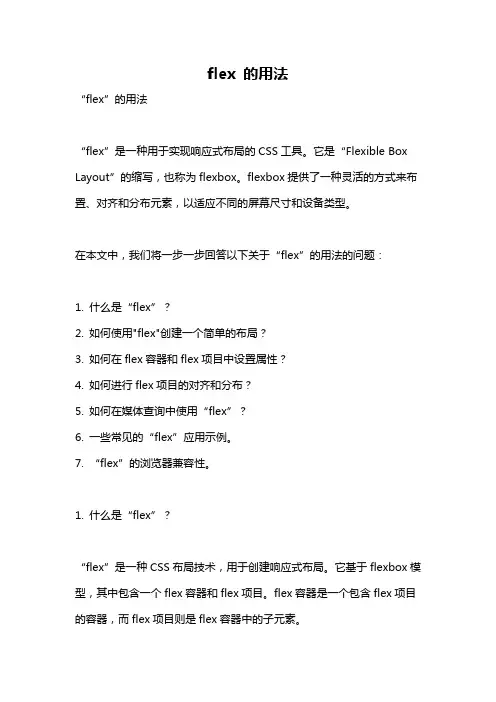
flex 的用法“flex”的用法“flex”是一种用于实现响应式布局的CSS工具。
它是“Flexible Box Layout”的缩写,也称为flexbox。
flexbox提供了一种灵活的方式来布置、对齐和分布元素,以适应不同的屏幕尺寸和设备类型。
在本文中,我们将一步一步回答以下关于“flex”的用法的问题:1. 什么是“flex”?2. 如何使用"flex"创建一个简单的布局?3. 如何在flex容器和flex项目中设置属性?4. 如何进行flex项目的对齐和分布?5. 如何在媒体查询中使用“flex”?6. 一些常见的“flex”应用示例。
7. “flex”的浏览器兼容性。
1. 什么是“flex”?“flex”是一种CSS布局技术,用于创建响应式布局。
它基于flexbox模型,其中包含一个flex容器和flex项目。
flex容器是一个包含flex项目的容器,而flex项目则是flex容器中的子元素。
2. 如何使用"flex"创建一个简单的布局?要创建一个简单的flex布局,首先需要创建一个flex容器。
我们使用`display: flex;`来将一个元素设置为flex容器。
接下来,我们可以使用其他属性来设置容器的方向、换行、对齐等属性。
css.container {display: flex;flex-direction: row;justify-content: space-between;align-items: center;}在上面的示例中,我们将一个元素的类名设置为“container”,然后使用`display: flex;`将其设置为flex容器。
接下来,我们使用`flex-direction: row;`设置容器内项目的排列方向为水平方向,使用`justify-content: space-between;`设置项目之间的间距,使用`align-items: center;`设置项目在容器中的垂直方向上的对齐方式。
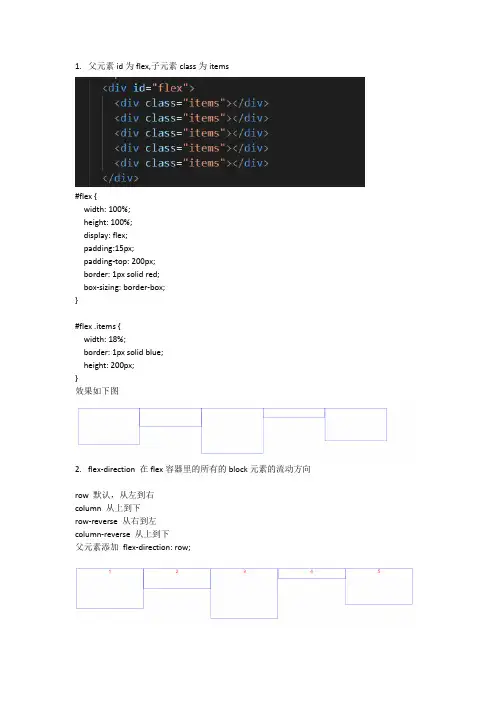
1.父元素id为flex,子元素class为items#flex {width: 100%;height: 100%;display: flex;padding:15px;padding-top: 200px;border: 1px solid red;box-sizing: border-box;}#flex .items {width: 18%;border: 1px solid blue;height: 200px;}效果如下图2.flex-direction 在flex容器里的所有的block元素的流动方向row 默认,从左到右column 从上到下row-reverse 从右到左column-reverse 从上到下父元素添加flex-direction: row;父元素添加flex-direction:row-reverse父元素添加flex-direction:column父元素添加flex-direction:column-reverse3.flex-wrap 控制如果当前行的位置不足时,是否换行,默认是不换行,会一直在一行中挤压,会改变在该行元素的宽度,将其排在一行之中nowrap 不换行wrap 换行,空间不足,就向下另起一行。
wrap-reverse 换行,与wrap不同的是,这个是向当前行的上面另起一行。
注意:flex-direction和flex-wrap经常一起使用所有有个缩写属性flex-flow:flex-direction flex-wrap。
父元素添加flex-flow:row nowrap;父元素添加flex-flow:row wrap;父元素添加flex-flow:row wrap-reverse;4.justify-content主轴的对齐方式,元素在容器中的对齐方式,与左对齐,右对齐,居中对齐类似取值:flex-start 靠近主轴的开始方向,如果从左到右就靠左,相反就靠右。
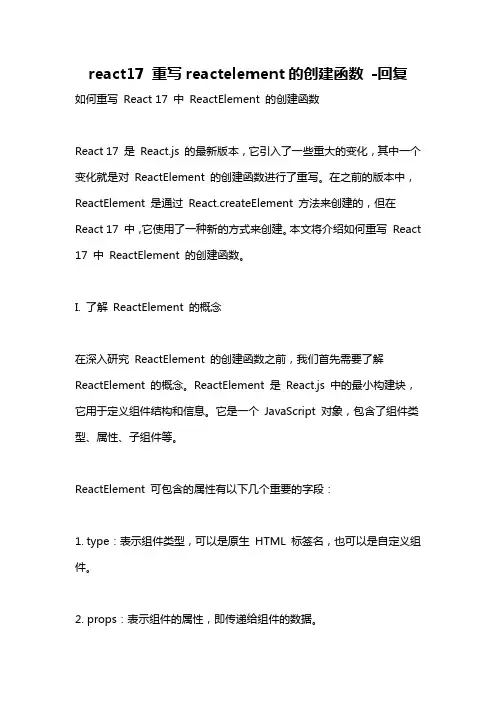
react17 重写reactelement的创建函数-回复如何重写React 17 中ReactElement 的创建函数React 17 是React.js 的最新版本,它引入了一些重大的变化,其中一个变化就是对ReactElement 的创建函数进行了重写。
在之前的版本中,ReactElement 是通过React.createElement 方法来创建的,但在React 17 中,它使用了一种新的方式来创建。
本文将介绍如何重写React 17 中ReactElement 的创建函数。
I. 了解ReactElement 的概念在深入研究ReactElement 的创建函数之前,我们首先需要了解ReactElement 的概念。
ReactElement 是React.js 中的最小构建块,它用于定义组件结构和信息。
它是一个JavaScript 对象,包含了组件类型、属性、子组件等。
ReactElement 可包含的属性有以下几个重要的字段:1. type:表示组件类型,可以是原生HTML 标签名,也可以是自定义组件。
2. props:表示组件的属性,即传递给组件的数据。
3. key:用于给列表中的每个元素分配一个唯一的标识,用于优化列表的渲染性能。
4. ref:用于获取组件实例或DOM 元素。
在React 17 中,ReactElement 的创建方式发生了变化,我们需要手动调用一个新的函数来创建ReactElement。
II. 重写ReactElement 的创建函数React 17 中重写ReactElement 的创建函数可以依次进行以下步骤:1. 导入React 模块首先,我们需要导入React 模块,以便在我们的代码中使用它提供的函数和类。
javascriptimport React from 'react';2. 创建一个函数来替代React.createElement在React 17 中,我们需要手动创建一个函数来替代React.createElement。
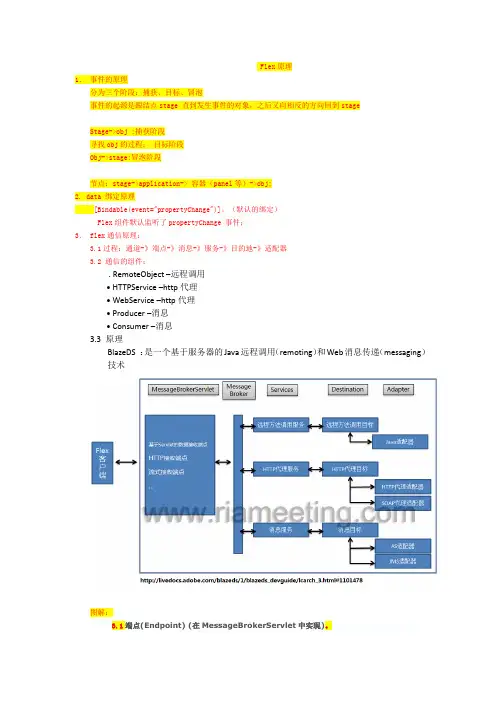
Flex原理1.事件的原理分为三个阶段:捕获、目标、冒泡事件的起源是跟结点stage 直到发生事件的对象,之后又向相反的方向回到stageStage->obj :捕获阶段寻找obj的过程:目标阶段Obj->stage:冒泡阶段节点:stage->application-> 容器(panel等)->obj;2. data 绑定原理[Bindable(event="propertyChange")]。
(默认的绑定)Flex组件默认监听了propertyChange 事件;3. flex通信原理:3.1过程:通道-》端点-》消息-》服务-》目的地-》适配器3.2 通信的组件:. RemoteObject –远程调用• HTTPService –http代理• WebService –http代理• Producer –消息• Consumer –消息3.3 原理BlazeDS :是一个基于服务器的Java远程调用(remoting)和Web消息传递(messaging)技术图解:3.1端点(Endpoint) (在MessageBrokerServlet中实现)。
endpoint,其默认形式是/messagebroker/amf通道类型:amf Channel(速度快)、httpChannel(二进制无压缩的)等消息通过channel传到endPoint ,Channel 和endpoint的编码格式必须一致比如都用amf的3.2. messgeBroker(消息代理人)messgeBroker 将消息根据(destination)服务请求的种类,传给不同的服务,服务再传到对应的服务的destination3.3.Service and destination 类别remoteService->remoteServiceDestination(RomoteObject 对象)->remote-config.xmlhttpproxyService->httpproxyserviceDestination(httpService\webService 对象)->proxy-config.xmlmessageservice->messageDestination(producer\consumer 对象)->message-config.xmldestination:目标其实是一个请求的目标:对于常用的远程方法调用来说,其目标(destination)就是某个特定的java服务,或者某个特定的配置好的Java类对于代理目标来说,则是定义好的代理种类,比如说普通HTTP代理还是基于WebService的代理对于消息目标来说,则是某个特定的消息服务种类3.4.AdapterRemote->javaadapterProxy->httproxyAdaper\soapadaperMessage->jms or as(客户端交换信息)4. flex 配置Flex socket 通信1.DataGrid1.dataGrid 数据的处理itemClick 事件:event:ListEvent;(var grid:DataGrid= event.target as DataGrid)所点击列的表头:grid.columns[event.columnIndex].headerText;列索引:event.columnIndex;行索引:event.rowIndex;选中的行数据:grid.selectedItem选中的单元格数据:grid.selectedItem[grid.columns[e.columnIndex].dataFiled]2. DataGrid 数据的移动方法:grid.removeItemAt;grid.addItemAt;3. Mxml中引入xml文件(利用HTTPService)可以作为dataGrid的数据源实例:<mx:HTTPService id="simpletest"url="assets\photoFood.xml"result="photoColl=stResult.list.food"/>注意:private var photoColl:arrayCollection;或者用监听方式取回结果:Private function onResult(event:ResultEvent):void{This. photocell=event.result.list.food ;}photoFood.xml:<list><food><food_name>Artichoke Dip</food_name><photo>artichokeDip.jpg</photo></food><food><food_name>Bread Pudding</food_name><photo>breadPudding.jpg</photo></food><food><food_name>Cheesecake</food_name><photo>cheesecake.jpg</photo></food></list>4.dataGrid 的itemReader 可以是自定义的任何组件;rendererIsEditor="true" :渲染的组件可以编辑,并且编辑后的值可以返回到datagrideditorDataField="value"(默认为“text”):渲染器要编辑的属性5.ArrayCollection的过滤器:实例:利用combobox控制数据的显示private function myFilter():void{if(this.myCom.selectedItem.toString()=="ALL"){this.reviewList.filterFunction=null;}else{this.reviewList.filterFunction=myFunc;}//refresh() 必须添加的方法this.reviewList.refresh();}//过滤器的筛选规则返回值为boolean,参数为容器的一个对象private function myFunc(item:Object):Boolean{return(item.rating.toString()==this.myCom.selectedItem.toString());}<mx:ComboBox dataProvider="{}" change="myFilter()" id="myCom"/>Private var com:ArrayCollection=new ArrayCollection(["1","2","3","4","5","ALL"]);DataGrid颜色专题总结:1。
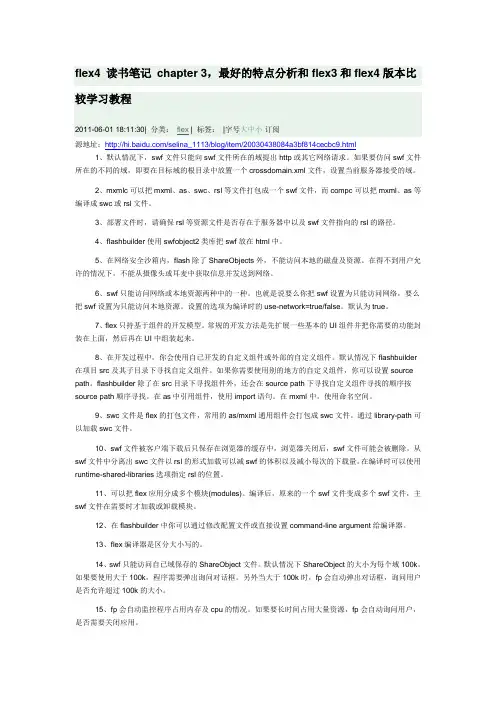
flex4 读书笔记chapter 3,最好的特点分析和flex3和flex4版本比较学习教程2011-06-01 18:11:30| 分类:flex | 标签:|字号大中小订阅源地址:/selina_1113/blog/item/20030438084a3bf814cecbc9.html1、默认情况下,swf文件只能向swf文件所在的域提出http或其它网络请求。
如果要仿问swf文件所在的不同的域,即要在目标域的根目录中放置一个crossdomain.xml文件,设置当前服务器接受的域。
2、mxmlc可以把mxml、as、swc、rsl等文件打包成一个swf文件,而compc可以把mxml、as等编译成swc或rsl文件。
3、部署文件时,请确保rsl等资源文件是否存在于服务器中以及swf文件指向的rsl的路径。
4、flashbuilder使用swfobject2类库把swf放在html中。
5、在网络安全沙箱内,flash除了ShareObjects外,不能访问本地的磁盘及资源。
在得不到用户允许的情况下,不能从摄像头或耳麦中获取信息并发送到网络。
6、swf只能访问网络或本地资源两种中的一种。
也就是说要么你把swf设置为只能访问网络,要么把swf设置为只能访问本地资源。
设置的选项为编译时的use-network=true/false。
默认为true。
7、flex只持基于组件的开发模型。
常规的开发方法是先扩展一些基本的UI组件并把你需要的功能封装在上面,然后再在UI中组装起来。
8、在开发过程中,你会使用自已开发的自定义组件或外部的自定义组件。
默认情况下flashbuilder 在项目src及其子目录下寻找自定义组件。
如果你需要使用别的地方的自定义组件,你可以设置source path。
flashbuilder除了在src目录下寻找组件外,还会在source path下寻找自定义组件寻找的顺序按source path顺序寻找。
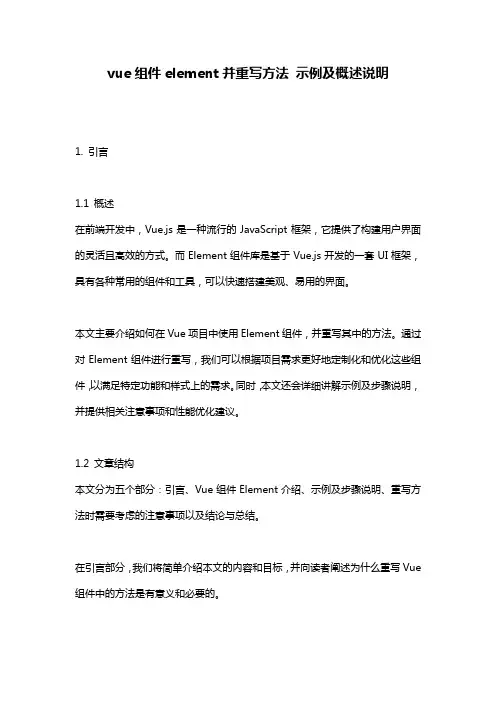
vue组件element并重写方法示例及概述说明1. 引言1.1 概述在前端开发中,Vue.js是一种流行的JavaScript框架,它提供了构建用户界面的灵活且高效的方式。
而Element组件库是基于Vue.js开发的一套UI框架,具有各种常用的组件和工具,可以快速搭建美观、易用的界面。
本文主要介绍如何在Vue项目中使用Element组件,并重写其中的方法。
通过对Element组件进行重写,我们可以根据项目需求更好地定制化和优化这些组件,以满足特定功能和样式上的需求。
同时,本文还会详细讲解示例及步骤说明,并提供相关注意事项和性能优化建议。
1.2 文章结构本文分为五个部分:引言、Vue组件Element介绍、示例及步骤说明、重写方法时需要考虑的注意事项以及结论与总结。
在引言部分,我们将简单介绍本文的内容和目标,并向读者阐述为什么重写Vue 组件中的方法是有意义和必要的。
本文旨在帮助读者更深入地理解如何使用Element组件库,并通过对其方法进行重写来满足特定需求。
通过学习本文,读者将能够轻松地集成和配置Element 组件库到Vue项目中,并了解为什么重写Vue组件的方法是一个优秀的选择,并掌握重写过程中需要考虑的注意事项和技巧。
同时,本文还将总结并讨论重写Vue组件Element方法的优势,以及进一步研究和发展的可能方向。
通过阅读本文,读者将能够在实际项目中灵活应用Element组件库,并根据需求进行必要的二次开发。
2. Vue组件Element介绍:2.1 Element组件库概述Vue组件Element是一个基于Vue.js的UI组件库,提供了丰富的可复用组件和强大的功能,以帮助开发者快速构建现代化的Web应用程序。
Element组件库不仅具有美观和易于使用的设计风格,还提供了大量的UI组件,如表单、导航、布局等,可以满足各种应用程序的需求。
此外,Element还支持国际化和自定义主题,使得开发者可以根据项目需求进行灵活定制。
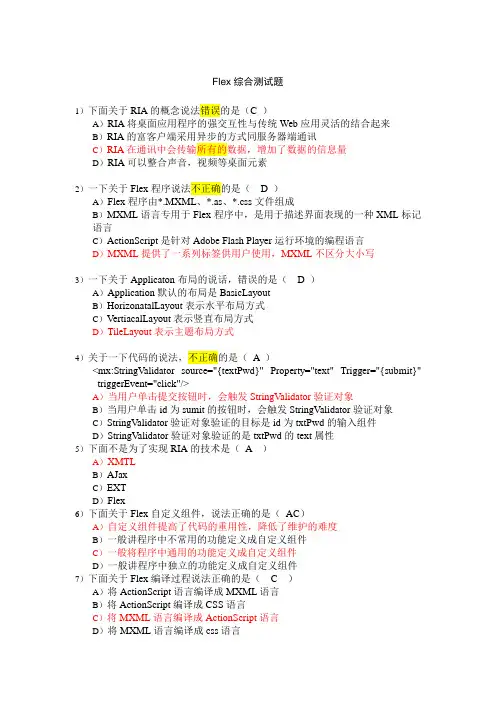
Flex综合测试题1)下面关于RIA的概念说法错误的是(C )A)RIA将桌面应用程序的强交互性与传统Web应用灵活的结合起来B)RIA的富客户端采用异步的方式同服务器端通讯C)RIA在通讯中会传输所有的数据,增加了数据的信息量D)RIA可以整合声音,视频等桌面元素2)一下关于Flex程序说法不正确的是( D )A)Flex程序由*.MXML、*.as、*.css文件组成B)MXML语言专用于Flex程序中,是用于描述界面表现的一种XML标记语言C)ActionScript是针对Adobe Flash Player运行环境的编程语言D)MXML提供了一系列标签供用户使用,MXML不区分大小写3)一下关于Applicaton布局的说话,错误的是( D )A)Application默认的布局是BasicLayoutB)HorizonatalLayout表示水平布局方式C)VertiacalLayout表示竖直布局方式D)TileLayout表示主题布局方式4)关于一下代码的说法,不正确的是(A )<mx:StringValidator source="{textPwd}" Property="text" Trigger="{submit}"triggerEvent="click"/>A)当用户单击提交按钮时,会触发StringValidator验证对象B)当用户单击id为sumit的按钮时,会触发StringValidator验证对象C)StringValidator验证对象验证的目标是id为txtPwd的输入组件D)StringValidator验证对象验证的是txtPwd的text属性5)下面不是为了实现RIA的技术是(A )A)XMTLB)AJaxC)EXTD)Flex6)下面关于Flex自定义组件,说法正确的是(AC)A)自定义组件提高了代码的重用性,降低了维护的难度B)一般讲程序中不常用的功能定义成自定义组件C)一般将程序中通用的功能定义成自定义组件D)一般讲程序中独立的功能定义成自定义组件7)下面关于Flex编译过程说法正确的是( C )A)将ActionScript语言编译成MXML语言B)将ActionScript编译成CSS语言C)将MXML语言编译成ActionScript语言D)将MXML语言编译成css语言8)下面是用于验证日期的是( D )A)<mx:StringValidatorB)<mx:EmailValidatorC)<mx:PhoneNumberValidatorD)<mx:DateValidator9)下面产生单选按钮的是( C )A)labelB)groupC)groupNameD)Groups10)下面关于TextInput的属性说法不正确的是( B )A)text表示得到用户输入的信息B)password表示以密码的形式显示信息C)restrict用于限定用户的输入D)Editable用于限定文本框是否可以输入11)下面对restrict的赋值能够限定文本框中仅能输入数字的是( B )A)$0-9B)0-9C)$0-9^D)0912)下面消息提示框Alert的说法正确的是( B )A)只能生成类似JavaScript的alert提示框B)能够生成类似JavaScript的conform效果C)只能指定消息的内容,不能为弹出框指定标题D)以上说话都不对13)AdvancedDataGrid组件用于绑定数据的属性是(C )A)designViewDataTypeB)columnsC)dataProviderD)data14)下面关于AdvancedDataGrid的显示形式说法正确的是( C )A)只能平面的形式B)只能是树形结构C)可以是平面结构,也可以是树形结构D)以上说法都不对15)关于AdvancedDataGrid绑定数据类型说法正确的是(D )A)只能是ArrayCollection数据类型B)只能是XML数据类型C)只能是XMLList类型D)可以是ActionScript定义的对象数组16)下面关于AdvancedDataGrid说法正确的是( B )A)AdvancedDataGrid不能对数据进行分组B)AdvancedDataGrid能够轻松实现显示摘要的效果C)不能对AdvancedDataGrid中的数据进行操作D)AdvancedDataGrid不能实现排序的功能17)下面关于Flex实现菜单导航效果的说法正确的是(C )A)利用tree组件完成菜单导航的效果B)利用AdvancedDataGrid实现菜单导航的效果C)利用MenuBar实现菜单导航的效果D)以上说法都不对18)下面关于Flex的动画效果说法正确的是(A )A)Flex可以利用定义好的组件,轻松的实现动画效果B)Flex不支持3D的动画效果C)Flex只能利用MXML组件实现动画效果D)Flex动画效果做起来很难,一般都不用19)下面关于淡入淡出效果说法正确的是( A )A)alphaFrom的值大的时候从不透明向透明转变B)alphaFrom的值大的时候从透明向不透明转变C)alphaFrom的值可以比1大D)alphaFrom不能比alphaTo 的值大20)关于Move3D动画效果说法正确的是( C )A)实现旋转功能B)实现淡入淡出功能C)实现移动功能D)实现变大变小功能21)关于Rotatee3D动画效果说法正确的是(A )A)实现旋转功能B)实现淡入淡出功能C)实现移动功能D)实现变大变小功能22)下面关于Flex移动动画说法正确的是(D )A)Flex的移动不能重复B)Flex的移动只能向一个方向移动,不能同时向多个方向移动C)Flex向Z轴方向的移动的值不能小于0,小于0会报错D)Flex向Z轴方向的移动的值能小于0,当小于0的时候表示向外移动23)关于Flex动画效果的持续时间说法正确的是(B)A)Flex动画的时间不能设定,都是1秒B)时间可以设定,用duration属性来设置持续时间C)Duration默认的时间用毫秒计算,如果需要持续3秒钟,其值应该是30000 D)Duration默认的时间用秒计算,如果需要持续3秒钟,其值应该是3 24)下面说法正确的是(B )A)Flex的动画效果一次只能使用一个,不能联合使用B)Flex的动画可以联合使用,但是有先后顺序C)Flex的动画可以联合使用,没有先后顺序D)以上说法都不对25)对于Tree组件的labelField属性赋值,正确的是( C )A)#labelB)$labelC)@labelD)%label26)在使用<s:Fade组件淡出淡入效果时候,alphaFrom属性的值正确的是(C )A)2 B)10 C)0.5 D)-127)在AS3.0中,用于创建Array数组正确的代码是( D )A)var Array temp = new Array();B)var temp:Array = new Array["a","b","c"];C)var temp:Array = ("a","b","c");D)var temp:Array = new Array("a","b","c");28)关于ArrayCollection过滤功能说法正确的是(AD )A)使用filterFunction属性指定过滤的函数名B)使用filter属性指定过滤的函数名C)ArrayCollection过滤函数类型必须是Boolean类型D)必须调用refresh方法使过滤生效29)关于Flex中视图状态,说法正确的是(BC )(选择两项)A)应用程序默认的视图状态为default视图状态B)应用程序默认的视图状态为在<s:states >中定义的第一个状态C)includeIn表示向视图中添加组件D)excludeFrom表示向视图中添加组件30)能够正确从目标对象的dragDrop事件中获取拖放数据的是(B )A)var dgRow:Object=event.dragSource.dataForFormat("item")[0];B)var dgRow:Object=event.dragSource.dataForFormat("items")[0];C)var dgRow:Object=event.dragSource.dataForFormat("items");D)var dgRow:Object=event.dragSource.dataForFormat("item");31)关于ActionScript说法正确的是( C )A)ActionScript是一个纯面向对象的编程语言B)ActionScript是一个纯面向过程的语言C)ActionScript是一个综合了面向过程和面向对象的编程语言D)以上说法都不对32)下面关于ActionScript面向对象的说法正确的是( C )A)ActionScript不支持重写B)ActionScript不支持继承C)ActionScript不支持重载D)ActionScript不支持封装33)Math.round()函数说法正确的是(BC )(选择两项)A)本函数支持保留小数B)本函数不支持保留小数,只能保留整数C)本函数是利用四舍五入的方式进行操作D)本函数是利用只舍不余的方式进行操作34)在ActionScript中如果要将数字进行四舍五入,并且保留小数,使用的方法是(D )A)Math.round()B)Math.floor();C)Math.ceil();D)Number.toFixed()35)ActionScript中循环说法正确的是(D)A)for循环,for in循环,for each循环是一样B)for循环不一样,for in和for each循环是一样C)for循环和for in循环是一样,for each不一样D)for循环,for in循环,for each循环都各有特点,不一样36)下面创建数组,错误的是( C )A)var bookArr:Array=new Array();B)var bookArr:Array=new Array("java","jsp","flex");C)var bookArr:Array=();D)var bookArr:Array=[“java”,“jsp”,“flex”];37)下面关于数据绑定的说法错误的是( C )A)使用数据绑定时,Flex会自动将一个对象的数据复制,提供给另一个对象使用,提供数据的一方称为数据源对象,使用数据的一方称为目标对象B)当数据源对象的数据发生改变化时,目标对象的数据会自动更新,而不需要再编写代码去强制更新C)当数据源对象的数据发生改变化时,目标对象的数据不会自动更新,需要再编写代码去强制更新D)绑定的实现是借助于事件机制来完成的38)下面关于AdvancedDataGrid拖放功能说法正确的是( A )A)dragEnabled="true"表示能够拖动B)dragEnabled="false"表示能够拖动C)dropEnabled="true" 表示能够拖动D)dropEnabled="false" 表示能够拖动39)下面关于Flex页面跳转的方式说法正确的是(A )A)可以使用ActionScrip调用JavaScript来实现跳转B)ActionScript是同JavaScript不同的编程语言,ActionScript不能使用JavaScript来实现页面的跳转C)JavaScript调用ActionScript来实现页面的跳转D)以上说法都不对40)下面关于HttpService组件的说法正确的是(B )A)是直接调用Java类的进行通信的方式B)是来通过Http请求的方式来同后台进行通信C)是同WebService进行通信的一种方式D)是调用Flex其他组件的一种方式41) 下面关于HttpService来进行通信的说法正确的是(B )A)服务器端可以直接以Java对象来响应客户端的请求B)服务器只能通过xml,Json对象等的形式来响应客户的请求C)服务器必须通过WebService的方式来响应请求D)以上的方式都行41)下面关于WebService组件说法正确的是( C )A)是直接调用Java类的进行通信的方式B)是来通过Http请求的方式来同后台进行通信C)是同WebService进行通信的一种方式D)是调用Flex其它组件的一种方式42)下面关于Remoting组件说法正确的是( A )A)是直接调用Java类的进行通信的方式B)是来通过Http请求的方式来同后台进行通信C)是同WebService进行通信的一种方式D)是调用Flex其他组件的一种方式44)下面关于Flex直接调用Java类的说法正确的是(C )A)Flex只能调用普通的Java类,不能调用被Spring管理的类B)Flex可以直接调用Java类,不需要借助任何的其他的插件C)Flex调用Java类的时候需要增加一个插件D)以上的说法都对45)下面关于Flex调用Java类的说法正确的是( D )A)需要将要被Flex调用的Java类注册到flex-config.xml文件中B)需要将要被Flex调用的Java类注册到service-config.xml文件中C)需要将要被Flex调用的Java类注册到application-config.xml文件中D)需要将要被Flex调用的Java类注册到remoting-config.xml文件中46)下面关于Flex直接调用Java类的说法正确的是(C)A)只能传递文本数据,不能传递对象B)只能传递对象,不能传递文本数据C)能够传递对象,但是对象需要系列化D)能够传递对象,|对象不需要系列化47)下面关于HttpService说法正确的是(D )A)HttpService只能访问JSP不能访问Servlet,B)HttpService只能访问Servlet,不能访问JSPC)HttpService即不能访问JSP,又不能访问ServletD)HttpService即能访问JSP,又能访问Servlet48)下面关于Flex同后台通信说法正确的是(AD)(选择两项)A)必须通过回调函数得到服务器端的响应B)不需要通过回调函数,能够直接得到服务器端的响应C)只能捕获正确的响应,不能捕获错误的响应D)即能捕获正确的响应,又能捕获错误的响应49)关于Flex图表说法正确的是(C )A)Flex只能绘制静态的图表,没有实用价值B)Flex只能绘制简单的图表,没有实用价值C)利用Flex的图表功能能够轻松的绘制出各种动态的图表,功能强大D)Flex的图表组件功能强大,不需要借助任何组件,可以直接同后台进行通信50)下面关于<mx:LineChart>说法正确的是(B )A)是绘制饼图的组件B)是绘制线性图表的组件C)是绘制柱状图的组件D)是绘制表格的组件。
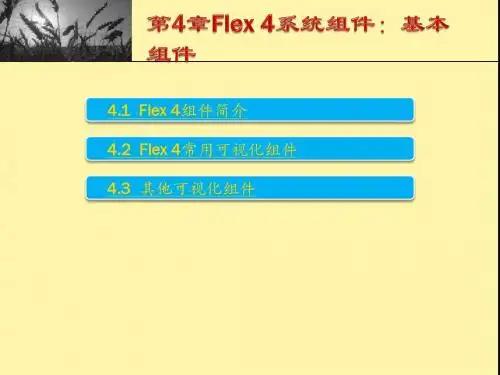
1.我不想在容器里显示滚动条怎么办?答:指定horizontalScrollPolicy和verticalScrollPolicy为off2.请问Flex bulider3可以创建几种不同的项目?答:三种。
Flex Project、AS Project 和Flex Library Project。
3.你了解RSL嘛?请说明下RSL的使用方法,以及使用RSL为了解决什么问题?答:RSL(Runtime shared libraries)即动态链接库,在程序运行时由FlashPlayer动态加载。
静态链接库是SWC文件,通过编译器的library-path和include-libraries编译进应用程序。
采用静态链接的应用程序SWF 会产生比较大的文件以及更长的下载时间。
使用RSL的应用程序载入时间短且文件比较小,而且提高了内存使用效率,只是在开始需要花点时间下载RSL。
RSL的强大体现在多个应用程序共享公共代码时,因为RSL只需要被下载一次,多个应用程序动态链接到相同的RSL,访问其中已经缓存在客户端的资源。
使用RSL:(1).在项目文件夹中点右建,选择"properties"-"Flex Build Path"-"Library Path"(2).该选项卡上我们看到"FrameWork linkage",默认是"Merged into cdoe"(FLEX4默认是RSL)(3).点开下拉,选择"runtime shared library(RSL)"(4).针对自定义的SWC,修改其link type为RSL,选择None,同时勾上Automatically extract swf to deployment path(自动将SWF提取到部署路径)。
如果想对不同域的RSL共享,则选择Digests(摘要),同时指定其Policy file url(策略文件)。
Flex布局总结之flex的主要属性及参数⽤法这篇笔记是系统学习flex时所记,适合复习使⽤,新⼿学习还是要配合图⽰和代码来学习更容易理解。
flex布局模型:弹性盒⼦( Flexible Box 或 flexbox),是⼀种当页⾯需要适应不同的屏幕⼤⼩以及设备类型时确保元素拥有恰当的⾏为的布局⽅式。
引⼊弹性盒布局模型的⽬的是提供⼀种更加有效的⽅式来对⼀个容器中的⼦元素进⾏排列、对齐和分配空⽩空间。
⾸先要弄清楚⼏个重要概念:flex-container:弹性盒⼦容器flex-items:flex-container⾥⾯的直接⼦元素叫做flex-items主轴:main axis:main start & main end & main size交叉轴:cross axis:cross start & cross end & cross size⽤在flex container上的CSS属性:flex-flow、flex-direction、flex--wrap、justify-content、align-items、align-content应⽤在flex items上的CSS属性:flex、flex-grow、flex-basis、flex-sshrink、order、align-self开启flex布局:.box { display:flex or inline-flex; } // 块级元素或⾏内元素1. flex-direction :决定了main axis主轴⽅向,默认沿着main axis主轴从main start开始从main start开始往main end⽅向排布。
row---默认从左⾄右, row-reverse----从右⾄左, column----从上⾄下, column-reverse----从下⾄上2. justify-content:决定了flex items在主轴上的对齐⽅式flex-start-----默认与main start对齐, flex-end------与main end对齐, center-------居中对齐space-between-----两边对齐中间等分间距对齐, space-evenly-----等分间距对齐, space-around-----边距时中间距离⼀半3. align-items:决定了flex items在cross axis上的对齐⽅式normal------效果相当于stretch-----当flex items在cross axis⽅向的size为auto时,会⾃动拉伸⾄填充flex containerflex-start----默认与cross start对齐, flex-end------与cross-end对齐, center------居中对齐, baseline------基线对齐,第⼀⾏⽂本底部为基线4. flex-wrap:默认nowrap,不换⾏;wrap,换⾏。
react 重写组件方法React 是一个用于构建用户界面的JavaScript 库。
当我们使用React 来开发应用程序时,经常会涉及到重写组件方法。
本文将介绍如何使用React 来重写组件方法,并提供一些实际案例以帮助读者更好地理解。
为了保证文章的质量和可读性,本文将遵循以下要求。
在文章中,我们将使用合适的段落和标题来组织内容,使文章结构清晰。
我们将尽量避免重复内容,并确保整体格式规范整洁。
我们需要了解何时需要重写组件方法。
当我们在React 中定义一个组件时,通常会包含一些生命周期方法和自定义方法。
在某些情况下,我们可能需要更改或扩展这些方法的功能。
这时,我们就需要重写组件方法。
下面是一个示例:```class MyComponent extends ponent {componentDidMount() {// 在组件挂载后执行的操作}handleClick() {// 处理点击事件的逻辑}render() {// 渲染组件的逻辑}}```在上面的示例中,`componentDidMount` 是一个生命周期方法,用于在组件挂载后执行某些操作。
`handleClick` 是一个自定义方法,用于处理点击事件的逻辑。
如果我们需要更改这些方法的功能,就需要重写它们。
接下来,我们将介绍如何重写组件方法。
在React 中,我们可以通过继承`ponent` 并重写相应的方法来实现。
下面是一个重写 `componentDidMount` 方法的示例:```class MyComponent extends ponent {componentDidMount() {// 在组件挂载后执行的新操作// 具体逻辑...}render() {// 渲染组件的逻辑}}```在上面的示例中,我们重写了 `componentDidMount` 方法,并在其中添加了新的操作。
通过这种方式,我们可以灵活地改变组件方法的功能。
标题:element el-cascader 样式重写一、背景介绍element-ui 是一款基于 Vue.js 的组件库,被广泛应用于各种 Web 开发项目中。
其 el-cascader 组件作为级联选择器,经常被用于多级联动选择的场景。
然而,由于 el-cascader 组件自带的样式在某些情况下无法满足需求,因此需要对其样式进行定制化重写,以达到更好的用户体验和视觉效果。
二、样式重写的需求1. 加强可定制化:当前 el-cascader 的样式设置较为受限,无法满足个性化的需求,需要进行样式定制化重写。
2. 增强交互体验:通过样式重写,优化el-cascader 组件的交互效果,提升用户操作的友好性和直观性。
3. 统一视觉风格:在项目中为了保持一致的视觉风格,需要对 el-cascader 组件的样式进行统一定制。
三、样式重写的方法1. 定制化主题样式:通过修改 el-cascader 组件的主题样式文件,实现样式的个性化定制。
2. 使用 CSS 选择器:通过在项目中使用 CSS 选择器对 el-cascader组件的样式进行覆盖和修改,实现样式重写。
3. 针对性的样式调整:根据具体项目需求,对 el-cascader 组件的不同状态和交互效果进行针对性的样式调整。
四、样式重写的注意事项1. 兼容性考虑:在进行样式重写时,需要考虑不同浏览器的兼容性,尽量避免出现样式显示异常或兼容性问题。
2. 状态切换优化:针对 el-cascader 组件的展开和收起状态,需要对样式进行优化,以便用户能够清晰地感知当前组件的状态切换。
3. 交互效果衔接:样式重写需要与 el-cascader 组件的交互效果相衔接,确保用户操作的连贯性和直观性。
五、样式重写的实践1. 确定需求:根据项目需求和设计要求,明确 el-cascader 组件样式重写的具体目标和要求。
2. 编写样式文件:针对 el-cascader 组件,编写定制化的样式文件,包括主题颜色、边框样式、字体大小等。
重写组件一、为什么要重写组件1、在FLEX已有组件无法满足业务需求,或是需要更改其可视化外观等特性时,直接进行继承扩展。
举例,继承BUTTON组件的长文本却不自动换行的自定义控件。
2、为了模块化设计或进一步重用,需要对FLEX组件进行组合。
比如一个包括TEXTAREA,BUTTON的复合控件。
二、重写组件需要经常换位思考的三个角色1、作为重写组件的使用者,有哪些需求。
比如需要在MXML标签和AS代码中暴露哪些属性及对应默认值、事件和事件的处理逻辑。
2、重写组件一般需要使用FLEX原有组件,要站在原有开发者的角度了解设计规则。
3、作为重写组件的设计者,在满足需求的情况下尽量做到可复用、低耦合易扩展等设计原则,让新组件像FLEX原组件一样好用。
三、重写组件AS方式和MXML方式的采用规则1、MXML文件和AS文件最后都会被编译成AS类,只不过MXML编译速度稍慢一些2、如果MXML和AS都能完成的一个简单组件,MXML更容易被创建和控制布局3、当要覆盖组件的某些方法时只能用AS方式4、创建一个直接继承UIComponent的子类时只能用AS5、创建非可视化组件比如Formatter、validator、Effect……时,只能用AS6、要为组件添加日志功能时,只能用AS.四、AS方式重写组件常规步骤1、如果有必要,为组件创建所有基于标记(tag-based)的皮肤(skins)2、创建ActionScript类文件⑴从一个基类扩展,比如UIComponent或者其他的组件类⑵指定使用者能够通过MXML标记进行设置的属性⑶嵌入(Embed)所有的图片和皮肤文件,文件大小尽可能小⑷实现构造器,可以设置属性和样式的缺省值,或者初始化数据结构,比如数组⑸根据需要,确定是否覆盖以下五个方法:(a)UIComponent.createChildren()方法,创建组件的子组件(b)mitProperties()方法,提交组件所有的属性变化,设置measure()方法可能使用的属性值。
vue重写第三方组件的方法在使用Vue开发时,我们通常会使用第三方组件来提高开发效率。
然而,有时候我们需要对这些第三方组件进行一些定制或者修改以满足项目的特定需求。
在这种情况下,我们可以通过重写第三方组件的方法来实现这些定制化功能。
重写第三方组件的方法有以下几种:1. 组件继承:可以通过继承第三方组件的方式,创建一个子类组件,并在子类组件中修改或添加需要的功能。
这种方法适用于需要在原有组件基础上增加或修改少量功能的情况。
通过继承,我们可以重写父组件的方法,或者在子组件中添加新的方法和属性。
2. 插槽(slot):有些第三方组件提供了插槽的功能,可以让我们在组件内部自定义内容。
通过使用插槽,我们可以将自定义的内容注入到组件中,实现对组件的定制化。
这种方法适用于需要在第三方组件的特定位置添加自定义内容的情况。
3. Mixin混入:Mixin是一种在Vue中重用组件逻辑的方式。
我们可以创建一个Mixin对象,然后将其混入到第三方组件中,从而拓展组件的功能。
Mixin可以包含组件的生命周期钩子、方法和数据等,通过混入到第三方组件中,可以拓展组件的功能并重写相应的方法。
4. 扩展组件选项:Vue提供了extend方法,可用于扩展组件选项。
我们可以创建一个新的组件选项对象,然后使用extend方法将第三方组件和新的组件选项进行合并,从而创建一个新的组件。
在新的组件中,我们可以对第三方组件的属性、方法、模板等进行修改或添加。
需要注意的是,在重写第三方组件之前,我们应该先了解第三方组件的使用文档和源码,确保对其结构和功能有一定的了解。
此外,重写第三方组件可能会导致与原组件的兼容性问题,因此在进行重写时应谨慎操作,并进行充分的测试来确保功能和性能的稳定性。
Flex 自定义组件一般都要重写下面几个方法,他们的主要作用是什么呢?下面举例说明:1.关于 createChildren()方法代码1-1显示了组件 ImageViewer 的 createChildren() 方法。
代码1-1. ImageViewer 的 createChildren() 方法1.override protected function createChildren():void2.{3.trace('createChildren');4.super.createChildren();5.6.//创建边框CSS7.if(!this.border){8.createBorder();9.}10.11.//创建控制按钮容器12.i f(!controlBar)13.c ontrolBar =new UIComponent();14.15.//创建放大按钮16.i f(!zoomInButton){17.z oomInButton =new Button();18.z bel="+";19.z oomInButton.addEventListener(MouseEvent.CLICK,zoomInButtonClickHandler);20.c ontrolBar.addChild(zoomInButton);21.}22.23.//创建缩小按钮24.i f(!zoomOutButton){25.z oomOutButton =new Button();26.z bel="-";27.z oomOutButton.addEventListener(MouseEvent.CLICK,zoomOutButtonClickHandler);28.c ontrolBar.addChild(zoomOutButton);29.}30.31.// 将控制按钮容器添加到显示节点32.a ddChild(controlBar);33.}在该方法的末尾才把controlBar 添加到 Display List 上,正如之前提到的那样,我们只在需要的时候装配他。
同时,此时也是为子节点添加监听器的好地方。
2.关于 commitProperties()方法CommitProperties()是验证方法 invalidateProperties()所对应的提交方法,也是初始化阶段会被调用的第一个提交方法。
他的目的是使得任何通过 set 方法提交的数值更改生效。
所以您可以看到在 set scale()方法里,按照invalidation-validation 模式,我们调用了 invalidateProperties()方法从而将值的生效延迟到了 commitProperties()里,并且为了做到“避免对一个属性连续设置多个值,从而避免了不必要的资源浪费”,我们使用了标志位scaleChanged。
代码2-1 set scale()函数1.public function set scale(value:Number):void{2.if(_scale !=value)3.{4._scale =value;5.6.//避免对一个属性连续设置多个值,从而避免了不必要的资源浪费7.scaleChanged = true;8.9.//由于调用本方法时,可能对象未创建10.//通过调用invalidateProperties(),将值的生效延迟到了commitProperties()里11.i nvalidateProperties();12.d ispatchEvent(new Event("scaleChanged"));13.}14.}代码2-2 commitProperties()函数1.override protected function commitProperties():void{2.trace('commitProperties');mitProperties();4.5.//如果image控件不存在,则新建并添加6.if(sourceChanged){7.if(!this.image){8.image=new Image();9.this.addChild(image);10.i mage.source=this._source;11.}else{12.i mage.source=this._source;13.}14.s ourceChanged = false;15.}16.17.//如果scale属性改变了,则修改imageWidth18.i f(scaleChanged){19.t his.imageWidth =this.imageWidth *this.scale;20.t his.imageHeight =this.imageHeight *this.scale;21.s caleChanged = false;22.}23.}为什么在 commitProperties()会有添加子节点的操作呢?对于有些子节点,他的诞生可能是和某些属性值相关联的,也就是我们在之前提到的动态创建或者数据驱动的子节点。
这些子节点,由于他们并不是随着组件的产生而产生,而是要受属性值的变化而产生或者变化,甚至在某些情况下,根本就不需要存在。
所以我们应该在值的提交阶段,也就是 commitProperties()方法调用的时候,当新值真正生效的时候再去创建它。
3.关于 measure() 方法measure()方法是组件自动计算尺寸大小的地方,在例子 ImageViewer 的measure()方法里(如代码3-1 所示).如果已经指定了尺寸大小,即 width 和height 值,measure()方法不会被调用。
所以一旦您的组件在组装阶段被设置了 with 和 height 属性值,那么请不要期望在 measure 里会执行您的业务逻辑。
代码3-1 measure()函数1.override protected function measure():void{2.trace('measure ');3.super.measure();4.if(!image){5.//如果image控件不存在,则本组件的宽度为controlBar的宽度6.measuredWidth = controlBar.getExplicitOrMeasuredWidth();7.measuredHeight = controlBar.getExplicitOrMeasuredHeight();8.}else{9.//如果image控件存在,则本组件的宽度为controlBar的宽度10.m easuredWidth =image.width+Math.max(image.width,controlBar.getExplicitOrMeasuredWidth());11.m easuredHeight =image.height+controlBar.getExplicitOrMeasuredHeight();12.}13.m easuredMinWidth = measuredWidth;14.m easuredMinHeight = measuredHeight;15.}4.关于 updateDisplayList ()方法updateDisplayList()方法用于对组件内容进行布局以及渲染,一切屏幕上可见的内容都需要在这里被处理,所以 updateDisplayList()可以说是最繁忙的一个提交方法,他所包含的实现可以非常多。
代码4-1中,我们省略了部分代码。
只留下了需要讲解的部分。
代码4-1 updateDisplayList()函数部分代码1.override protected function updateDisplayList(unscaledWidth:Number,unscaledHeight:Number):void{2.super.updateDisplayList(unscaledWidth, unscaledHeight);3.// 省略部分代码4.zoomInButton.setActualSize(50, 20);5.zoomOutButton.setActualSize(50, 20);6.var tmpx :Number= 20;7.controlBar.setActualSize(tmpx, 20);8.controlBar.move(0, unscaledHeight-25);9.zoomInButton.move(tmpx, 0);10.t mpx +=60;11.z oomOutButton.move(tmpx, 0);12.i f(imageHeightChanged ||imageWidthChanged){13.i mage.width=this.imageWidth;//w;14.i mage.height=this.imageHeight;//h - 20;15.v ar tempX :Number= x+(w-imageWidth)* 0.5;16.v ar tempY :Number= y +(h-imageHeight)* 0.5;17.i mage.x = tempX;18.i mage.y = tempY;19.i mageHeightChanged = false ;20.i mageWidthChanged = false ;21.v ar g:Graphics=graphics;22.g.clear();23.g.beginFill(0x6F7777);24.g.drawRect(tempX-1, tempY-1, imageWidth+2, imageHeight+2);25.g.endFill();26.}27.}在 measure()方法里我们可以获取 Flex 自动计算的尺寸(如果被调用的话),这些数据需要在 updateDisplayList() 方法里被应用处理,所以我们会大量使用 setActualSize()方法,特别是子元素比较多的时候。
updateDisplayList()的最重要的职责之一就相对应的 invalidateDisplayList ()方法的更新请求进行响应。
比如说对set imageWidth()方法进行了相应。
并且就像在 commitProperties()部分里介绍的那样,这里同样使用了“标志位”方法来进行“局部跟新”。